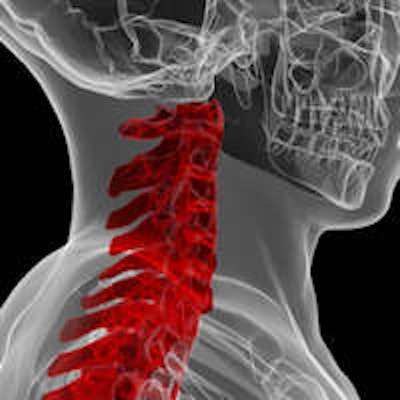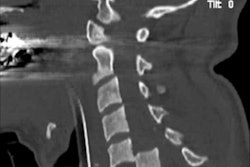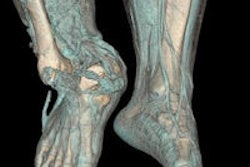
Many cervical spine injuries identified on subsequent CT scans are not visible on plain radiographs, and there is also a high rate of technical inadequacy of cervical spine plain radiography in trauma cases, according to award-winning research presented at a major scientific meeting held in Melbourne, Australia, earlier this month.
"There remains controversy as to the optimal initial imaging modality in alert patients who are symptomatic and of low risk for cervical spine injury," noted lead author Dr. C. Werren, a radiology registrar at Sir Charles Gairdner Hospital in Nedlands, Western Australia, and colleagues from the Royal Perth Hospital.
Current international guidelines differ in their choice of cervical spine x-ray (CSXR) or CT. For instance, the National Institute for Health and Care Excellence (NICE) in the U.K. and the British Trauma Society recommend radiography as a screening tool unless high risk factors are present, but in the U.S., the Eastern Association for the Surgery of Trauma (EAST) and American Association of Neurological Surgeons (AANS) recommend CT as a first-line modality for all trauma patients with suspected cervical spine injuries.
At the Combined Scientific Meeting (CSM), which took place in Melbourne, Australia, from 4 to 7 September, Werren et al collected the I-MED Best Emergency Radiology Scientific Exhibit Prize for their work on the incidence of radiographically occult fractures and technical inadequacy in trauma patients undergoing cervical spine clearance imaging in the emergency setting.
In a concurrent audit of radiation dose at Royal Perth Hospital, the median doses of radiography and CT were found to be more similar than expected at 0.877 mSv and 2.33 mSv respectively. The development of low-dose protocols on newer scanners means the use of CT as a first-line examination may be considered in line with the recent EAST and AANS guidelines, they pointed out in their CSM e-poster.
Comparison of adequate CSXR to CT for cervical spine injury in trauma gives a sensitivity of 52% to 65%. The large, multicenter National Emergency X-Radiography Utilization Study (NEXUS) trauma trial produced a considerably higher sensitivity of 89% for clinically significant injuries detected with adequate radiographs. It is clear that CSXR misses injuries, but there is a paucity of literature that demonstrates whether universal use of CT results in a change in patient outcome, the researchers wrote.
Study details
Using the local PACS, they retrospectively selected all patients who had both CSXR at Royal Perth Hospital and subsequent cervical spine CT within two months in 2012. They collected data from the medical notes, PACS, and Western Australia (WA) state trauma registry. Collected variables included mechanism of injury, injury severity score (ISS), patient demographics, and reasons for progression to CT. The research team also recorded details of CT and radiograph reports, spinal precautions, clinical course and management, and explored the relationships between missed injuries and the above variables using both logistic regression and spline transformation.
The group assessed the accuracy of plain radiography compared with CT and the effect of this on patient management and outcome. They analyzed patient demographics and ISS to determine factors associated with a higher risk of radiographically occult cervical spine injury or technical inadequacy of plain radiographs.
Of the included 273 patients (69% male, media age 40), 43 were found to have cervical spine fractures on CT, giving a fracture rate in this selected population of 15.7%. Five ligamentous injuries were detected. Of these injuries, 39 of the fractures and all five ligamentous injuries required management. A total of 27 patients were immobilized using an orthosis, seven were immobilized with a halo vest, and 10 underwent surgical intervention.
The probability of a missed cervical spine injury with a technically adequate radiograph was 6.1%. There was a significant association between the probability of a missed cervical spine injury and both increasing age and ISS when both adequate and inadequate radiographs were included in the analysis.
Eleven cervical spine injuries visible on CT were occult on an initial review of an adequate radiograph by a radiology registrar or emergency department staff, yielding a sensitivity of 69% (95% C.I. 52-81%) compared with CT. Eight of these occult injuries required management and five of those requiring management were deemed to have no radiographic evidence of acute pathology on review by consultants, or senior radiologists. This gives a sensitivity of 83% (95% C.I. 66-93%) for consultant-reported radiographs for cervical spine injuries requiring management.
Five patients with cervical spine injury had spinal precautions removed prematurely and three patients with cervical spine injuries were discharged and then readmitted, one of these was managed surgically with anterior cervical discectomy and fusion (ACDF). Only one injury requiring management was found to be occult to both consultant radiograph review and clinical suspicion in the emergency department.
A total of 29% of radiographs were technically inadequate, reported Werren and colleagues. This rate of technical inadequacy is similar to the figure of 30% cited in the NEXUS trial. The probability of a missed injury with an adequate radiograph was 6% compared with 6.9% with an inadequate radiograph.
"This was a retrospective audit performed on a convenience sample, which results in limitations in both data collection and interpretation," they explained. "As this sample includes only patients who had both CT and radiograph, it is likely to overestimate the probability of a missed injury when compared with the whole population of trauma patients imaged with cervical spine radiographs. An increase in probability of missed injury with increasing ISS was expected given cervical spine injuries are included in the score."
As the probability of a missed cervical spine injury increases with age and radiation dose becomes less important, initial CT is likely to be appropriate in an older population, the authors concluded.
The central theme of the CSM 2014 congress was "Imaging and Radiation in Personalized Medicine," and it was organized jointly by the Royal Australian and New Zealand College of Radiologists, Australian Institute of Radiography, and the Australasian College of Physical Scientists and Engineers in Medicine.



















